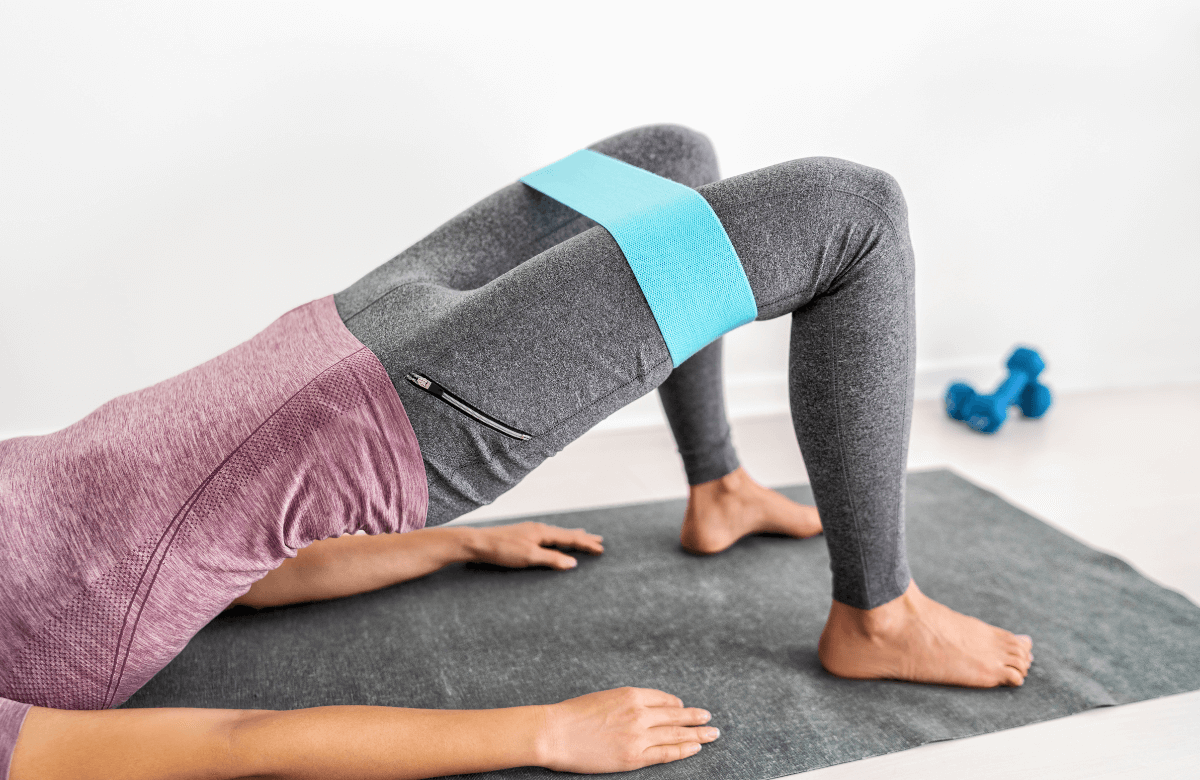Depending on your bone structure, level of body fat, and body shape, you might have something called hip dips. Hip dips are common and there’s nothing wrong with having them.
Interestingly enough, hip dips were not often discussed 30 years ago. People are more focused on them now thanks to a recent social media fitness trend that discusses what hip dips are and ways to get rid of them.
Hip dips are not a bad thing. They’re simply a product of your genetics. But if the appearance of hip dips is something you don’t like about yourself, you might be looking into ways to eliminate them.
It is possible to get rid of hip dips with exercise, but surgery is available as a last resort. Let’s take a closer look at hip dips and how to use exercise to beat them.
Jump to:
- What Causes Hip Dips?
- Are Hip Dips Normal?
- What’s the Difference Between Hip Dips and Love Handles?
- Can You Get Rid of Hip Dips?
- Can You Exercise Away Hip Dips?
- 7 Exercises to Get Rid of Hip Dips
- How Long Does It Take to See Hip Dip Before and After Results with Exercise?
- What to Expect from Your Body Before and After Hip Dip Exercises
- Can You Eliminate Hip Dips Without Exercise?
- What to Expect Before and After Hip Dip Surgery
What Causes Hip Dips?
Hip dips, sometimes called violin hips, are a result of your genetic body structure. They’re very common, but not everyone has them. Usually, it’s based on the shape of your pelvis and the position of your hips. If your hip bones are significantly higher than your femur, both muscle and fat will curve into your hip bone, causing a dip in the curve of your hips.
Hip dips simply refer to the indentation that occurs at the top of the thigh. This indentation is usually seen on the outer thighs, but you can also see it at the top of your upper thighs on some. If your pelvis is more pointed, it becomes more obvious to the naked eye.

Are Hip Dips Normal?
Completely normal. Everyone has this indentation at the top of their thighbone, but it’s not always apparent. The shape and position of muscles and bone structure can make it look more obvious to some. But if we looked at a person’s skeletal structure alone without flesh or muscle, everyone would have hip dips.
It’s very important to understand that having hip dips does not mean that you’re overweight or unhealthy. It’s true that if you have more body fat, hip dips will look more obvious.
Different body types are more likely to see more prominent hip dips. Pear or A-shaped bodies and hourglass or X-shaped bodies are more likely to have larger hip dips. However, if you have one of those body types it doesn’t mean you will have hip dips.
Current beauty standards seem to think that hip dips aren’t attractive, but that doesn’t mean they’re right, and you shouldn’t feel ashamed if you have them.
What’s the Difference Between Hip Dips and Love Handles?
The position of love handles is what separates them from hip dips.
Hip dips occur at the base of your hip bones, where the top of your femur meets the top of your thigh. Love handles appear at the top of your hips.
Love handles, also called muffin tops, are fat deposits on top of your hip bones, on your sides.
Hip dips are directly correlated with your bone structure. But love handles do not correlate with bone structure. They’re simply a genetic factor that influences where your body stores fat in your middle.

Can You Get Rid of Hip Dips?
In writing this article, we don’t want to give the impression that we believe hip dips are bad in any way. Just like there’s nothing wrong with your eye color, there’s nothing wrong with having hip dips.
But we also know that many of our readers are here because they have a goal to improve their physical health and get rid of excess body fat. So if you have a goal to get rid of your hip dips for self-improvement, know that it is possible!
The two most common ways to eliminate hip dips are through diet plus exercise and body sculpting procedures. We highly recommend exercise and healthy eating as your first line of defense and surgery as a last resort, but you can consult with your doctor to make the right decision for you.
Can You Exercise Away Hip Dips?
You can’t completely eliminate hip dips because they’re the result of your skeletal structure. However, you can significantly reduce the appearance of hip dips through exercise.
Because hip dips become more prominent due to the fat stores around your hip bones and muscles, focusing on fitness can help. As you strengthen and grow the muscles around your hips and pelvis, you can help to diminish fat stores and get a firmer shape.

7 Exercises to Get Rid of Hip Dips
If you want to focus on a healthy body, choosing full-body workouts is a great way to go. You can also isolate certain areas of your body that you’d like to see improved.
For your hip dips, you’ll do a lot of leg workouts to strengthen and grow the muscles surrounding your hips and pelvis. Here are a few workouts you can start with.
1. Fire Hydrants
Fire hydrants offer a great way to work both your abdominal muscles and the muscles surrounding your hips.
To do fire hydrants, get down on all fours. Lean your torso forward while you lift one leg to the side, the leg bent at 90 degrees at the knee. Push your knee forward slightly until you feel a squeeze in your abdominals and then return to starting position.
This exercise should target your glutes, adding extra strength to these muscles and targeting your body fat stores in that region.
Start with 3 sets of 10 reps.
2. Squats
Squats are about as basic as it comes to building lower body muscle but don’t underestimate their ability to shape your body. As long as you’re doing squats properly, you can strengthen the quads, hips, glutes, and all the surrounding muscles.
Bodyweight squats are a great place to start, but as you get stronger, you can add in weights or deepen your squats to increase their effectiveness.
Squats are awesome because they’re so accessible. Almost anyone can do a squat, barring any orthopedic restrictions, and you can do them anywhere. So even if you don’t have time to hit the gym after work, you can still do a few squats on your lunch break.
Aim for 4 sets of 10-12 squats.
3. Standing Side Leg Lifts
Standing side leg lifts are also relatively accessible. You’ll stand with your feet shoulder-width apart and tuck your pelvis for stability. Keeping your trunk as upright as possible, kick your leg straight out to the side, raising it as high as you can without pain.
If this exercise is too intense for you at the start, try lying on your side. It exercises similar muscles but is a little easier on the knees.
This exercise targets your outer thighs, hips, and glutes, so it hits all the muscles you want it to for those pesky hip dips.
Go for 3-4 sets of 10-12 side leg raises each.
4. Clam Lifts
Lie on your side in a loose fetal position. Your spine should be slightly curved with your legs stacked on top of each other and bent slightly in front of you. Keeping your heels together, raise your top knee to full extension, keeping the other on the ground. Bring it back to the start position, pause, and repeat.
This simple, yet highly effective exercise targets the glutes, outer thighs, inner thighs, and surrounding muscles. It also gets some of your lower abs and back muscles.
Shoot for 2 sets of 20 reps on each leg.
5. Leg Kickbacks
Here’s a simple accessible exercise that effectively tightens your glutes while tackling muscles on your outer thigh.
Stand with feet hip-width apart with your pelvis tucked and abs engaged. Keeping your trunk steady, gently kick your leg behind you, keeping the knee straight. Extend as far as you can without pain and return to the start.
You can increase the intensity of this exercise with cable kickbacks in which you use an ankle strap attached to a weight machine. You’ll kick back, pulling the weights up and giving you a more intense workout.
You can also do a version of this exercise nicknamed donkey kicks. You’ll kneel on all fours and kick your leg straight behind you so your body makes a straight line back to heel.
Go for 3 sets of 10-12 kickbacks, no matter the variation you choose.
6. Glute Bridges
The glute bridge is a staple in hip-friendly workouts.
Start by lying on your back with your knees bent and feet flat on the ground. Place your hands flat on the ground on either side of your hips. Using your glutes and abs, raise your butt off the ground until your body makes a straight line from chin to knees. Pause at full extension and slowly lower to the ground, keeping your abs tight and your body controlled.
This is a great starting point for this workout. As you get stronger, you can add weights or resistance bands to intensify the movement. You should feel it in your abs, glutes, and quads.
Do 3-4 sets of 10 reps.
7. Side Lunges
The side lunge is an excellent lower body move for boosting glute and hip strength. While the movement is very simple, you want to keep your body controlled and steady to avoid injury.
In some ways, a side lunge resembles a wide-legged squat but on one leg at a time. You’ll stand with your legs wide and lean to one side. You’ll drop your butt behind you and squat on one leg while the other is straight. Keep your back straight as well, and don’t let your knee stick out past your toe.
After slowly returning to the starting position, lean to the other side and perform the same movement. Go as deeply as you can into the side lunge while keeping the movement controlled.
An alternative move to the side lunge is the curtsy lunge, which helps to tighten the muscles around your outer and inner hips alongside your glutes.
Do 3 sets of 12 reps on each leg.
How Long Does It Take to See Hip Dip Before and After Results with Exercise?
The time frame for seeing before and after hip dip results from regular exercise varies on many factors such as your fitness level, what you eat, how often you exercise, and your genetics. However, most people will see noticeable results around the 6-8 week mark.
Be sure to take pictures before you begin exercising and then again after 6 weeks of exercising. This will help you to see the results of your hard work. Based on what you see, you might make adjustments to your exercise or diet to improve your results.
What to Expect from Your Body Before and After Hip Dip Exercises
You should see a change in your body after doing these exercises that target your hip area. You’ll primarily see noticeable changes in your lower body strength. It’s impossible not to get stronger if you’re doing the above-mentioned exercises regularly.
If you were to take a body fat test, you would also see a decrease in body fat levels and an increase in body muscle. Muscle metabolizes faster than fat, so you might even see some weight loss.
Will your hip dips completely disappear after doing these exercises? Probably not. You’ll still be able to see a slight indentation simply because your bone structure is set. Your fat will dissipate, but your muscles are still there and growing. So it won’t be as noticeable without the fat stores there but don’t expect it to completely disappear.
Additionally, please note that your results will vary based on how often you exercise and what you eat. If you’re still eating 500 calories more than you burn every day, you won’t shed fat as quickly as you might like.

Can You Eliminate Hip Dips Without Exercise?
Yes, there are a couple of ways to reduce the appearance of hip dips without exercise. One is to enter a calorie deficit, aiming to lose no more than 2 lbs per week. This will help your body to burn its fat stores and eliminate the excess fat around your hips.
Another option is body contouring surgery to correct hip dips. Usually, this form of body contouring surgery involves lipo sculpting or transferring fat from one area of the body to another.
Typically, we recommend making this procedure a last-resort option. There are always risks that go with body contouring. Not to mention, it’s expensive and you might not see the results you want.
What to Expect Before and After Hip Dip Surgery

If you decide to take on this fat transfer procedure, you might wonder what to expect before and after the surgery.
If you decide to undergo the actual procedure, you’ll start with a consultation from a cosmetic surgeon. They’ll develop a customized plan and take pre-op photos before scheduling your procedure.
During the procedure, you’ll be under anesthesia for three or four hours. The surgeon may transfer fat from your buttocks, belly, or inner thigh and use it to fill the space between the top of your thigh and your pelvis, thus eliminating any hip dips.
After the procedure, you’ll be sent home for 1-3 weeks to recover. You should see a smoother contour in the hip area as a result.

Is Hip Dip Surgery Safe?
All surgeries carry risks, but most experts consider hip dip surgery to be generally considered safe. You should always speak with your primary healthcare provider to assess whether or not you’re healthy enough for the procedure.
If you have poor reactions to anesthesia, you might prefer not to do the surgery. Additionally, make sure you understand the fat grafting procedure and assess your medical history to hopefully prevent problems.
Following the exact instructions of your surgeon will also help to minimize your risk during recovery.
Is Hip Dip Surgery Effective?
Most people who undergo hip dip surgery see improvement in the contour of their hips. It can make a big difference for some, and the results can last a lifetime.
However, it may take several weeks for the fat grafting to fully take shape. You may also need additional touch-up procedures to keep the results looking good long term.
Is Exercise or Surgery More Effective for Eliminating Hip Dips?
Both exercise and surgery can be highly effective for minimizing the appearance of hip dips. We prefer taking the natural route of exercise and diet first to see if you can get the contour you prefer.
But hip dip surgery can be a good option if you can’t see the results you want from exercise alone. Filling the dip with this procedure may be a more effective way to see results quickly.
Ultimately, the results are up to you. Discuss your options with your healthcare provider to make the right choice for you.















